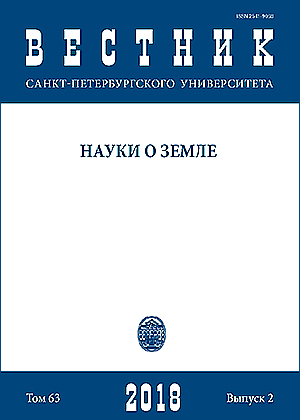Environmental assessment of risks associated with the Ordovician Dictyonema shale in the eastern part of the Baltic Klint
DOI:
https://doi.org/10.21638/11701/spbu07.2018.202Abstract
The results of research considered in this article made it possible to expand the understanding of the environmental risks associated with the highly radioactive bituminous argillites of the Baltic Sea region. The natural patterns of the distribution of natural radionuclides 226Ra, 232Th and 40K are established along the strike and thickness of layers. The average value of the effective specific activity (ESA) for all samples in the Koporka River valley amounted 1270 Bq/kg. The minimum value of ESA was 650 Bq/kg (the closest to the seam roof level), and the maximum value was 3750 Bq/kg (the second from the seam floor level). Conversion to mass fractions of natural radionuclides (NRN) showed that the average content of uranium in the sample amounted up to 90.7 g/t, thorium up to 11.4 g/t and of potassium up to 4.1%. The high heterogeneity of the content distribution of NRN along the strike of the Dictyonema shale seam was confirmed by studies of separate outcrops of highly radioactive rocks along the banks of the Tosna River. In general, the level of the argillites radioactivity has abnormally high value and exceeds the natural background more than ten times. The average annual values of the effective dose amounted from 5,8 to 10,7 mSv/year, that should be classified as the territories of emergency ecological danger and zones of ecological disaster.
Downloads
References
References
Downloads
Published
How to Cite
Issue
Section
License
Articles of "Vestnik of Saint Petersburg University. Earth Sciences" are open access distributed under the terms of the License Agreement with Saint Petersburg State University, which permits to the authors unrestricted distribution and self-archiving free of charge.






